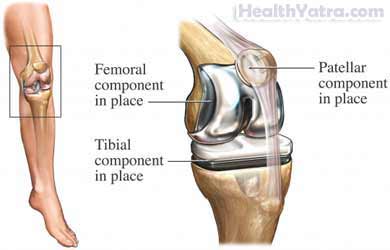Definition
Knee replacement, also called arthroplasty, is a surgical procedure to replace a knee damaged by disease or injury.
Recovery may take several weeks to months depending on your overall health.

Reasons for Procedure
This is done if you have chronic pain and stiffness in the knee joint that limits activities.
Knee replacement surgery is most often done to:
- Ease knee pain and disability due to arthritis or previous severe knee injury
- Correct a knee deformity
Possible Complications
Problems from the procedure are rare, but all procedures have some risk. Your doctor will review potential problems, like:
- Infection
- Excess bleeding
- Swelling
- Blood clots
- Chronic weakness in knee joint
- Worsening or unchanged pain
Factors that may increase the risk of complications include:
- Smoking
- Poor nutrition
- History of blood clots
- Long-term illness
- Use of certain medications
What to Expect
Prior to Procedure
Your doctor will likely do the following:
- Physical exam
- Blood tests
- X-ray
- MRI to get images of the internal structure of the knee
Before surgery, you will need to:
- Arrange for a ride home.
- Arrange for help at home while you recover.
- Talk to your doctor about any allergies you have.
- Ask your doctor about assisted devices you will need.
- If you are overweight, lose weight. This will help to decrease the amount of stress on your new joint.
- Install safety equipment in the bathroom, shower, and on the stairs.
- Prepare a bedroom on the first floor if possible. Climbing stairs will be difficult at first.
Talk to your doctor about any medications, herbs, or supplements you are taking. You may be asked to stop taking some medications up to one week before the procedure, like:
- Aspirin and other anti-inflammatory drugs
- Blood-thinning drugs, such as warfarin
- Anti-platelet drugs, such as clopidogrel
Do not eat or drink anything after midnight the day before your surgery, unless told otherwise by your doctor.
Anesthesia
Anesthesia will keep you pain-free and comfortable during the procedure. Anesthesia methods include:
- General anesthesia—you will be asleep
- Spinal or epidural anesthesia—your lower body will be numbed from an injection into the back
Description of the Procedure
The doctor will make a cut in the skin. The damaged cartilage and bone will be removed. The remaining bone will be prepared to receive the new joint made from material such as plastic and metal. The doctor will then place the artificial joint in the proper position. It may be cemented within the bone. The doctor will close the incision with staples. A drain will be left in to allow extra fluid to flow out.
How Long Will It Take?
About 2 hours.
How Much Will It Hurt?
Anesthesia will block pain during the procedure. You will have pain after the procedure. Ask your doctor about medication to help manage pain.
Average Hospital Stay
This procedure is done in a hospital setting. The usual length of stay is 3-4 days. Your doctor may choose to keep you longer if complications arise.
Post-procedure Care
At the Hospital
Right after the procedure, you will be taken to recovery and monitored closely. The staff may give you:
- A splint or brace to hold the knee in the right position
- Pain medication
- Antibiotics to prevent infection
- Medication that prevents blood clots
While you are recovering at the hospital, you may need to use a continuous passive motion machine, which is designed to:
- Slowly move your knee
- Restore function
- Decrease swelling
- Improve circulation
During your recovery, you will need to:
- Move your foot and ankle to increase blood flow back to your heart.
- Wear support stockings. These may help prevent blood clots from forming in your legs.
- Work with a physical therapist. You may start the day after surgery. You will learn safe ways to move your knee and support your weight.
- Wear a brace or splint. You will learn how to use a walker, crutches, or other support devices.
At Home
To help ensure a smooth recovery at home, take these steps:
- Keep the incision area clean and dry. Place a clean dressing over it.
- Ask your doctor about when it is safe to shower, bathe, or soak in water.
- Start working with a physical therapist once you are instructed to. The therapist will focus on balance, range-of-motion, and strength training.
- Maintain a healthy weight after surgery.
- Follow your doctor’s instructions.
Within six weeks, you should be able to go back to light activities and driving. You may feel a soft clicking in the joint when walking or bending. Continue to work with the physical therapist. Water-based exercises may help to improve joint pain, swelling around the knee, and range of motion.
After your knee replacement, you must take preventive antibiotics before dental or surgical procedures to prevent infection. Talk to your doctor before your dental appointments or any other surgery.
Call Your Doctor
Call your doctor if any of the following occurs:
- Signs of infection, including fever and chills
- Redness, swelling, increasing pain, excessive bleeding, or discharge from the incision site
- Swelling, redness, or pain in your legs, calves, or feet
- Pain that you cannot control with the medications you have been given
- Nausea and vomiting
- Cough, shortness of breath, or chest pain
- Your leg, foot, or toes appear chalky white, blue, or black
- Numbness or tingling in your leg, foot, or toes
- Pain, burning, urgency, frequency of urination, or persistent bleeding in the urine
If you think you have an emergency, call for medical help right away.
